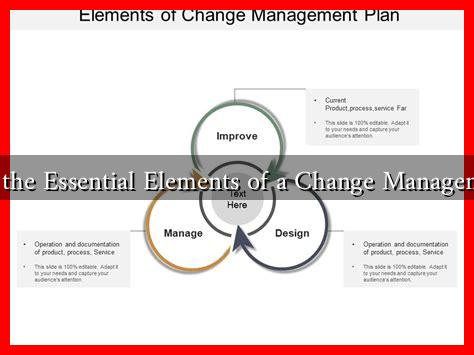-
Table of Contents
What Are the Essential Elements of a Change Management Plan?
Change is an inevitable part of any organization, whether it’s due to technological advancements, market shifts, or internal restructuring. A well-structured change management plan is crucial for ensuring that transitions are smooth and effective. This article explores the essential elements of a change management plan, providing insights and examples to help organizations navigate change successfully.
Understanding Change Management
Change management refers to the structured approach to transitioning individuals, teams, and organizations from a current state to a desired future state. It involves preparing, supporting, and helping individuals to adopt change in order to drive organizational success. According to a study by McKinsey, organizations that effectively manage change are 3.5 times more likely to outperform their peers.
Key Elements of a Change Management Plan
A comprehensive change management plan should include several essential elements:
- Clear Objectives: Define what the change aims to achieve. Objectives should be specific, measurable, achievable, relevant, and time-bound (SMART).
- Stakeholder Analysis: Identify all stakeholders affected by the change. Understanding their needs and concerns is vital for gaining support.
- Communication Plan: Develop a strategy for communicating the change to all stakeholders. This should include the rationale behind the change, the benefits, and how it will be implemented.
- Training and Support: Provide necessary training and resources to help employees adapt to the change. This could include workshops, online courses, or one-on-one coaching.
- Implementation Timeline: Create a detailed timeline that outlines when each phase of the change will occur. This helps in tracking progress and ensuring accountability.
- Feedback Mechanisms: Establish channels for feedback to gauge how the change is being received. This can help in making necessary adjustments along the way.
- Evaluation and Reinforcement: After implementation, assess the effectiveness of the change. Reinforce positive behaviors and outcomes to ensure long-term success.
Case Study: Successful Change Management in Action
One notable example of effective change management is the transformation of Microsoft under CEO Satya Nadella. When Nadella took over in 2014, he recognized the need for a cultural shift within the organization. He implemented a change management plan that included:
- Fostering a growth mindset among employees.
- Encouraging collaboration across teams.
- Investing in employee training and development.
As a result, Microsoft saw a significant increase in employee engagement and innovation, leading to a resurgence in its market position. This case illustrates how a well-executed change management plan can lead to substantial organizational benefits.
Statistics Highlighting the Importance of Change Management
Research indicates that effective change management can significantly impact an organization’s success:
- According to Prosci, organizations with a structured change management approach are 6 times more likely to meet or exceed project objectives.
- A study by the Project Management Institute found that organizations with high change management maturity are 2.5 times more likely to complete projects on time and within budget.
Conclusion: The Path to Successful Change
In conclusion, a well-defined change management plan is essential for navigating the complexities of organizational change. By focusing on clear objectives, stakeholder engagement, effective communication, and ongoing support, organizations can minimize resistance and enhance the likelihood of successful outcomes. As demonstrated by Microsoft’s transformation, the right approach to change management can lead to improved performance and a more resilient organizational culture.
For further reading on change management strategies, consider exploring resources from the Prosci website, which offers valuable insights and tools for managing change effectively.


